Sicco Verwer
State Frequency Estimation for Anomaly Detection
Dec 04, 2024



Abstract:Many works have studied the efficacy of state machines for detecting anomalies within NetFlows. These works typically learn a model from unlabeled data and compute anomaly scores for arbitrary traces based on their likelihood of occurrence or how well they fit within the model. However, these methods do not dynamically adapt their scores based on the traces seen at test time. This becomes a problem when an adversary produces seemingly common traces in their attack, causing the model to miss the detection by assigning low anomaly scores. We propose SEQUENT, a new approach that uses the state visit frequency to adapt its scoring for anomaly detection dynamically. SEQUENT subsequently uses the scores to generate root causes for anomalies. These allow the grouping of alarms and simplify the analysis of anomalies. Our evaluation of SEQUENT on three NetFlow datasets indicates that our approach outperforms existing methods, demonstrating its effectiveness in detecting anomalies.
Automated Test-Case Generation for REST APIs Using Model Inference Search Heuristic
Dec 04, 2024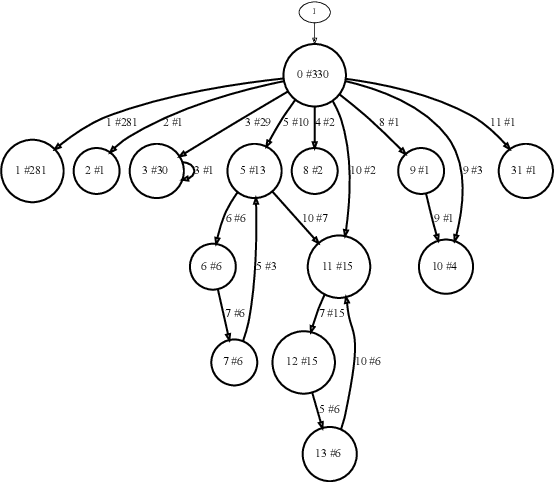
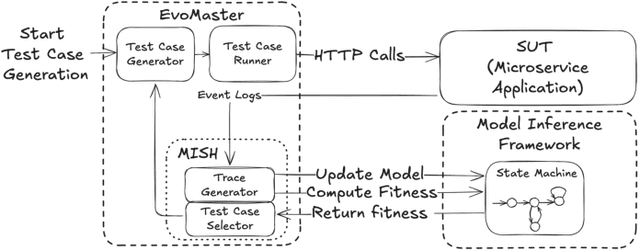
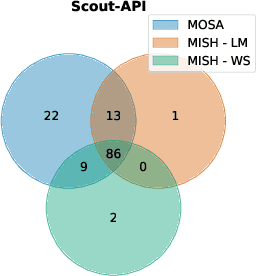
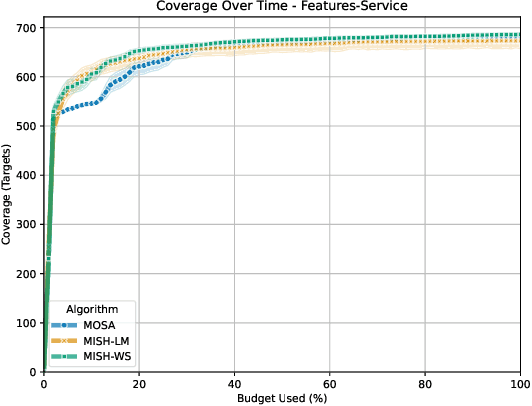
Abstract:The rising popularity of the microservice architectural style has led to a growing demand for automated testing approaches tailored to these systems. EvoMaster is a state-of-the-art tool that uses Evolutionary Algorithms (EAs) to automatically generate test cases for microservices' REST APIs. One limitation of these EAs is the use of unit-level search heuristics, such as branch distances, which focus on fine-grained code coverage and may not effectively capture the complex, interconnected behaviors characteristic of system-level testing. To address this limitation, we propose a new search heuristic (MISH) that uses real-time automaton learning to guide the test case generation process. We capture the sequential call patterns exhibited by a test case by learning an automaton from the stream of log events outputted by different microservices within the same system. Therefore, MISH learns a representation of the systemwide behavior, allowing us to define the fitness of a test case based on the path it traverses within the inferred automaton. We empirically evaluate MISH's effectiveness on six real-world benchmark microservice applications and compare it against a state-of-the-art technique, MOSA, for testing REST APIs. Our evaluation shows promising results for using MISH to guide the automated test case generation within EvoMaster.
Optimizing Interpretable Decision Tree Policies for Reinforcement Learning
Aug 21, 2024Abstract:Reinforcement learning techniques leveraging deep learning have made tremendous progress in recent years. However, the complexity of neural networks prevents practitioners from understanding their behavior. Decision trees have gained increased attention in supervised learning for their inherent interpretability, enabling modelers to understand the exact prediction process after learning. This paper considers the problem of optimizing interpretable decision tree policies to replace neural networks in reinforcement learning settings. Previous works have relaxed the tree structure, restricted to optimizing only tree leaves, or applied imitation learning techniques to approximately copy the behavior of a neural network policy with a decision tree. We propose the Decision Tree Policy Optimization (DTPO) algorithm that directly optimizes the complete decision tree using policy gradients. Our technique uses established decision tree heuristics for regression to perform policy optimization. We empirically show that DTPO is a competitive algorithm compared to imitation learning algorithms for optimizing decision tree policies in reinforcement learning.
PDFA Distillation via String Probability Queries {PDFA Distillation via String Probability Queries}
Jun 26, 2024Abstract:Probabilistic deterministic finite automata (PDFA) are discrete event systems modeling conditional probabilities over languages: Given an already seen sequence of tokens they return the probability of tokens of interest to appear next. These types of models have gained interest in the domain of explainable machine learning, where they are used as surrogate models for neural networks trained as language models. In this work we present an algorithm to distill PDFA from neural networks. Our algorithm is a derivative of the L# algorithm and capable of learning PDFA from a new type of query, in which the algorithm infers conditional probabilities from the probability of the queried string to occur. We show its effectiveness on a recent public dataset by distilling PDFA from a set of trained neural networks.
Differentially-Private Decision Trees with Probabilistic Robustness to Data Poisoning
May 24, 2023Abstract:Decision trees are interpretable models that are well-suited to non-linear learning problems. Much work has been done on extending decision tree learning algorithms with differential privacy, a system that guarantees the privacy of samples within the training data. However, current state-of-the-art algorithms for this purpose sacrifice much utility for a small privacy benefit. These solutions create random decision nodes that reduce decision tree accuracy or spend an excessive share of the privacy budget on labeling leaves. Moreover, many works do not support or leak information about feature values when data is continuous. We propose a new method called PrivaTree based on private histograms that chooses good splits while consuming a small privacy budget. The resulting trees provide a significantly better privacy-utility trade-off and accept mixed numerical and categorical data without leaking additional information. Finally, while it is notoriously hard to give robustness guarantees against data poisoning attacks, we prove bounds for the expected success rates of backdoor attacks against differentially-private learners. Our experimental results show that PrivaTree consistently outperforms previous works on predictive accuracy and significantly improves robustness against backdoor attacks compared to regular decision trees.
Optimal Decision Tree Policies for Markov Decision Processes
Jan 30, 2023Abstract:Interpretability of reinforcement learning policies is essential for many real-world tasks but learning such interpretable policies is a hard problem. Particularly rule-based policies such as decision trees and rules lists are difficult to optimize due to their non-differentiability. While existing techniques can learn verifiable decision tree policies there is no guarantee that the learners generate a decision that performs optimally. In this work, we study the optimization of size-limited decision trees for Markov Decision Processes (MPDs) and propose OMDTs: Optimal MDP Decision Trees. Given a user-defined size limit and MDP formulation OMDT directly maximizes the expected discounted return for the decision tree using Mixed-Integer Linear Programming. By training optimal decision tree policies for different MDPs we empirically study the optimality gap for existing imitation learning techniques and find that they perform sub-optimally. We show that this is due to an inherent shortcoming of imitation learning, namely that complex policies cannot be represented using size-limited trees. In such cases, it is better to directly optimize the tree for expected return. While there is generally a trade-off between the performance and interpretability of machine learning models, we find that OMDTs limited to a depth of 3 often perform close to the optimal limit.
SoK: Explainable Machine Learning for Computer Security Applications
Aug 22, 2022
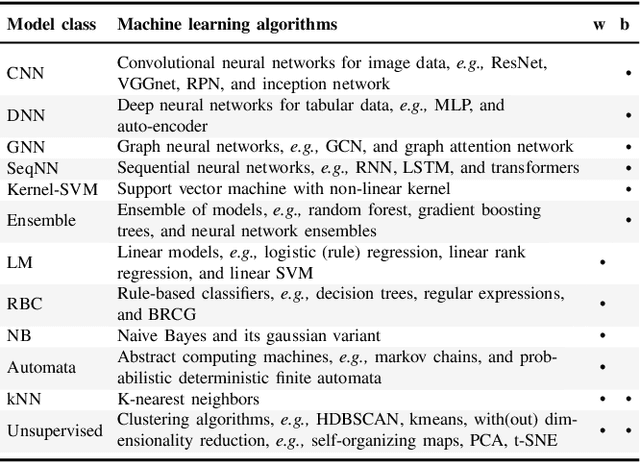
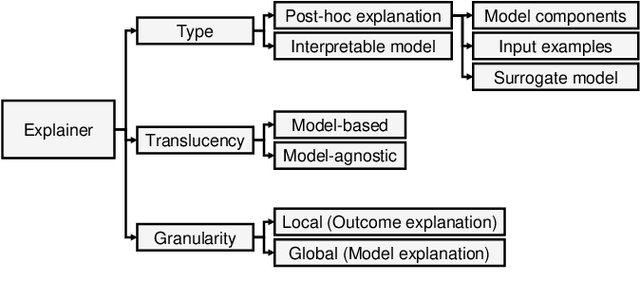
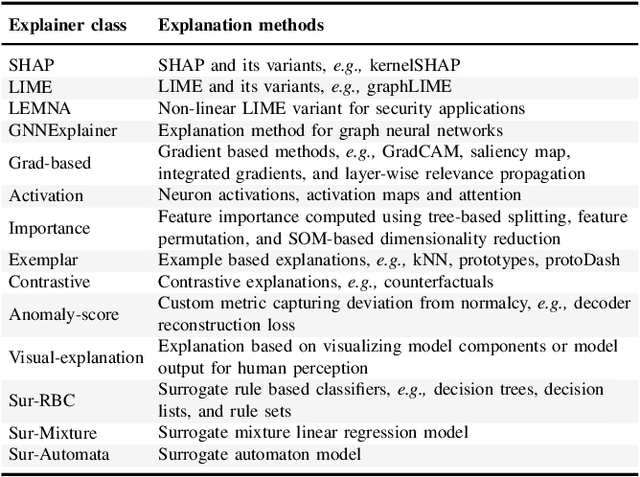
Abstract:Explainable Artificial Intelligence (XAI) is a promising solution to improve the transparency of machine learning (ML) pipelines. We systematize the increasingly growing (but fragmented) microcosm of studies that develop and utilize XAI methods for defensive and offensive cybersecurity tasks. We identify 3 cybersecurity stakeholders, i.e., model users, designers, and adversaries, that utilize XAI for 5 different objectives within an ML pipeline, namely 1) XAI-enabled decision support, 2) applied XAI for security tasks, 3) model verification via XAI, 4) explanation verification & robustness, and 5) offensive use of explanations. We further classify the literature w.r.t. the targeted security domain. Our analysis of the literature indicates that many of the XAI applications are designed with little understanding of how they might be integrated into analyst workflows -- user studies for explanation evaluation are conducted in only 14% of the cases. The literature also rarely disentangles the role of the various stakeholders. Particularly, the role of the model designer is minimized within the security literature. To this end, we present an illustrative use case accentuating the role of model designers. We demonstrate cases where XAI can help in model verification and cases where it may lead to erroneous conclusions instead. The systematization and use case enable us to challenge several assumptions and present open problems that can help shape the future of XAI within cybersecurity
Encoding NetFlows for State-Machine Learning
Jul 08, 2022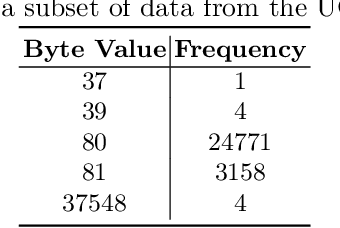
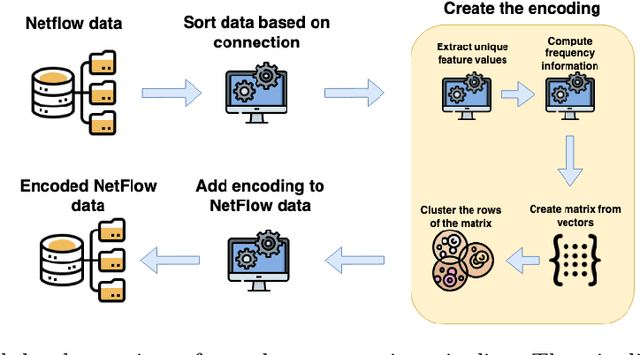
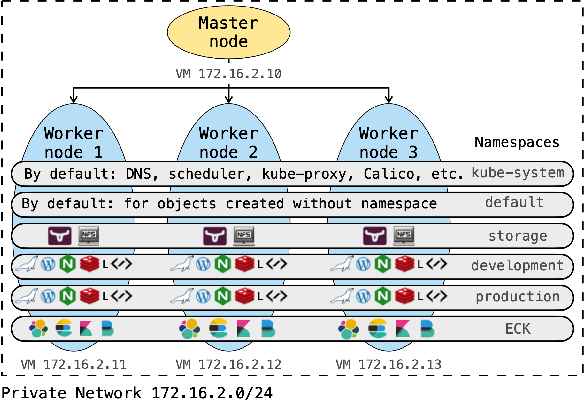
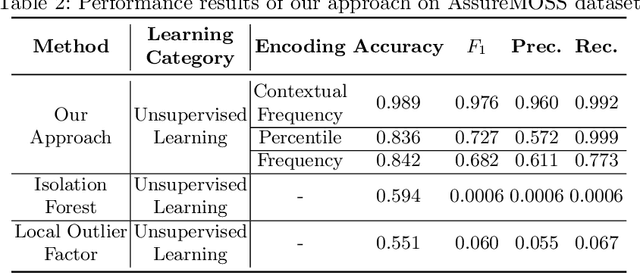
Abstract:NetFlow data is a well-known network log format used by many network analysts and researchers. The advantages of using this format compared to pcap are that it contains fewer data, is less privacy intrusive, and is easier to collect and process. However, having less data does mean that this format might not be able to capture important network behaviour as all information is summarised into statistics. Much research aims to overcome this disadvantage through the use of machine learning, for instance, to detect attacks within a network. Many approaches can be used to pre-process the NetFlow data before it is used to train the machine learning algorithms. However, many of these approaches simply apply existing methods to the data, not considering the specific properties of network data. We argue that for data originating from software systems, such as NetFlow or software logs, similarities in frequency and contexts of feature values are more important than similarities in the value itself. In this work, we, therefore, propose an encoding algorithm that directly takes the frequency and the context of the feature values into account when the data is being processed. Different types of network behaviours can be clustered using this encoding, thus aiding the process of detecting anomalies within the network. From windows of these clusters obtained from monitoring a clean system, we learn state machine behavioural models for anomaly detection. These models are very well-suited to modelling the cyclic and repetitive patterns present in NetFlow data. We evaluate our encoding on a new dataset that we created for detecting problems in Kubernetes clusters and on two well-known public NetFlow datasets. The obtained performance results of the state machine models are comparable to existing works that use many more features and require both clean and infected data as training input.
Learning state machines via efficient hashing of future traces
Jul 04, 2022



Abstract:State machines are popular models to model and visualize discrete systems such as software systems, and to represent regular grammars. Most algorithms that passively learn state machines from data assume all the data to be available from the beginning and they load this data into memory. This makes it hard to apply them to continuously streaming data and results in large memory requirements when dealing with large datasets. In this paper we propose a method to learn state machines from data streams using the count-min-sketch data structure to reduce memory requirements. We apply state merging using the well-known red-blue-framework to reduce the search space. We implemented our approach in an established framework for learning state machines, and evaluated it on a well know dataset to provide experimental data, showing the effectiveness of our approach with respect to quality of the results and run-time.
SECLEDS: Sequence Clustering in Evolving Data Streams via Multiple Medoids and Medoid Voting
Jun 24, 2022



Abstract:Sequence clustering in a streaming environment is challenging because it is computationally expensive, and the sequences may evolve over time. K-medoids or Partitioning Around Medoids (PAM) is commonly used to cluster sequences since it supports alignment-based distances, and the k-centers being actual data items helps with cluster interpretability. However, offline k-medoids has no support for concept drift, while also being prohibitively expensive for clustering data streams. We therefore propose SECLEDS, a streaming variant of the k-medoids algorithm with constant memory footprint. SECLEDS has two unique properties: i) it uses multiple medoids per cluster, producing stable high-quality clusters, and ii) it handles concept drift using an intuitive Medoid Voting scheme for approximating cluster distances. Unlike existing adaptive algorithms that create new clusters for new concepts, SECLEDS follows a fundamentally different approach, where the clusters themselves evolve with an evolving stream. Using real and synthetic datasets, we empirically demonstrate that SECLEDS produces high-quality clusters regardless of drift, stream size, data dimensionality, and number of clusters. We compare against three popular stream and batch clustering algorithms. The state-of-the-art BanditPAM is used as an offline benchmark. SECLEDS achieves comparable F1 score to BanditPAM while reducing the number of required distance computations by 83.7%. Importantly, SECLEDS outperforms all baselines by 138.7% when the stream contains drift. We also cluster real network traffic, and provide evidence that SECLEDS can support network bandwidths of up to 1.08 Gbps while using the (expensive) dynamic time warping distance.
 Add to Chrome
Add to Chrome Add to Firefox
Add to Firefox Add to Edge
Add to Edge